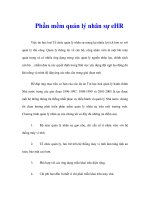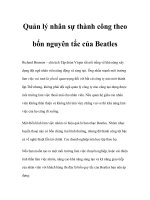Quản lý nhân sự quốc tế doc
Bạn đang xem bản rút gọn của tài liệu. Xem và tải ngay bản đầy đủ của tài liệu tại đây (138.15 KB, 22 trang )
INTERNATIONAL HUMAN
RESOURCE MANAGEMENT
Compensation &
Benefits
2
Expatriate Compensation &
Benefits
Compensation
Benefits
Compensation
Benefits
Employment and
Taxation Laws
Organization’s Com-
pensation Policy
Competitors
Standard of Living
Political and Social
Environment
Allowances
Economic
Conditions
Expatriate Costs
•
Expatriate costs may pose a multiple-
fold expense in relation to employees
who are not sent as expatriates to
foreign destinations, and are usually
significantly higher than the
compensation accorded to HCNs and
TCNs
3
4
•
Example:
•
a Chinese manager with 15 years
experience costs less than USD 70,000
per annum, while
•
a US expatriate manager with
corresponding expertise would cost his
or her organization USD 300,000 per
year
5
Goals of an International Organization’s
Compensation Policy (1)
1) Policy should be consistent with the overall
strategy, structure and business needs of the
international organization
2) Policy must work to attract and retain staff in those
areas where the international organization has the
greatest needs and opportunities. As a
consequence, the policy must be competitive and
recognize factors such as incentive for serving in a
foreign location, tax equalization and reimbursement
for reasonable costs
6
Goals of an International Organization’s
Compensation Policy (2)
3)Policy should facilitate transfer of
international employees in the most
cost-effective manner
4)Policy must give due consideration to
equity and ease of administration
7
Employee Expectations and International
Organization’s Compensation Policy
Financial protection in terms of benefits, social
security and cost of living in the foreign location
Foreign assignment offers opportunities for
advancement through income and/or savings
Issues such as housing, education of the children
and recreation are addressed
Note that the expectations of the employees often do not
coincide with the interests of the organization
Key Components of International
Compensation Programme for Expatriates
•
Base Salary
•
The base salary is usually the main
component in international compensation,
and is the main benchmark used for other
elements in an expatriate compensation
package, such as bonuses and benefits
•
The base salary is either paid in the
expatriate’s home or parent country
currency, or in the currency of the
expatriate’s host country
8
Key Components of International
Compensation Programme for
Expatriates
•
Hardship Premium
•
For expatriate’s (usually PCNs, TCNs)
who will encounter “hardships” caused
by the transfer to a foreign location,
determining the appropriate level of
payment can be difficult
9
10
•
Factors determining the hardship premium,
usually expressed in terms of an expatriate’s
base pay, are typically:
Assignment
Actual hardship
Tax consequences
Length of assignment
11
Key Components of International
Compensation Programme for Expatriates
Allowances: There are many types of allowances in
an international compensation package:
Cost of Living Allowance – Payment made to the
expatriate with a view to compensating for
differences in expenditure between the home or
parent country and the host country. Factors such
as inflation differentials and the price level need to
be considered. Often, the cost of living allowance
is difficult to determine
12
Key Components of International
Compensation Programme for Expatriates
Housing Allowance – Payment made to the expatriate with
a view to ensuring that he or she can maintain their home-
country living standard in the host country. Alternatively,
an organization may provide housing facilities on a
mandatory or optional basis. Also, support services may
be provided to the expatriate, for example, by helping sell
or rent the expatriate’s house in the home country
Home Leave Allowance – Payment made to the expatriate
with a view to facilitating their visit back to the home
country, once or twice a year. Home leave enables the
expatriate to renew business, family and social ties, and
thus avoid adjustment problems subsequent to repatriation
13
Key Components of International
Compensation Programme for Expatriates
Education Allowance – Payment made with a view to
supporting the education of the expatriate’s children, i.e.
tuition, language class, school enrollment fees, books and
supplies, transportation to educational establishment,
room and boarding, school uniforms etc. Problems
regarding the level of education required and adequacy of
schools in the host country, and transportation to other
localities may pose significant problems for organizations
Relocation Allowance – Payment made with a view to
enable the relocation of the expatriate to the assignment
location. Includes moving, shipping, storage costs,
subsidies for purchase of appliances and (possibly) an
automobile
14
Key Components of International
Compensation Programme for Expatriates
Miscellaneous Allowances – Depending on the
level of seniority of the expatriate, payments to
him or her for club memberships, sport
associations, maintenance of household staff etc.
may be rendered
In addition, the organization may render financial
assistance to the spouse for her or his loss of
income as a result of the transfer of the expatriate
15
Key Components of International
Compensation Programme for Expatriates
Benefits – Support rendered to an expatriate in addition to
the allowances provided. There are several types of
benefits, more prominent examples being:
Social Security Benefits (home country or host country?)
Paid Vacations for expatriate and family
Rest and Rehabilitation leave (especially for expatriates
based in “hardship” assignment locations)
Emergency Cases (severe illness, death)
16
Calculating International Compensation
There are two basic approaches used
to determine an international
compensation package:
The Going Rate Approach
The Balance Sheet Approach
17
The Going-Rate Approach
Based on local market rates
Relies on survey comparisons
–
Local nationals (HCNs)
–
Expatriates of same nationality
–
Expatriates of all nationalities
Compensation based on the selected survey comparison
Base pay and benefits may be supplemented by additional
payments for low-pay countries
Example: Should a Pakistani bank operating in London use
local British salaries, the salaries other Pakistani competitor
banks in London or the average salary offered by all foreign
banks operating in London as the reference point for the base
salary offered
18
Disadvantages of the Going-Rate Approach
ADVANTAGES
Equality with local nationals
Simplicity
Identification with host country
Equity amongst different
nationalities
ADVANTAGES
Equality with local nationals
Simplicity
Identification with host country
Equity amongst different
nationalities
DISADVANTAGES
Variation between assignments
for the same employee
Rivalry between expatriates
of same nationality in
getting assignments
to some countries
Potential reentry problems in
the home country
DISADVANTAGES
Variation between assignments
for the same employee
Rivalry between expatriates
of same nationality in
getting assignments
to some countries
Potential reentry problems in
the home country
19
Logic of the Balance Sheet Approach
•
The balance sheet approach to
international compensation is a system
designed to equalize the purchasing power
of employees at comparable position levels
living abroad and in the home country, and
to provide incentives t offset qualitative
differences between assignment locations
20
The Balance Sheet Approach
The balance sheet approach is widely used by
international organizations to determine the
compensation package for expatriates:
Basic objective is the maintenance of home-country
living standard, plus financial inducement
Home-country pay and benefits are the foundations of
this approach
Adjustments to home package to balance additional
expenditure in the host country
Financial incentives (expatriate / hardship premium)
added to make the package attractive
21
Outlays Considered in the Balance Sheet Approach
The balance sheet approach considers four types of outlays
which are incurred by expatriates:
Goods and services – Outlays incurred in the home country for
food, personal care, clothing, household furnishings, recreation,
transportation and medical care
Housing – All major costs associated with housing in the host
country
Income Taxes – Parent country and host country income tax
expenditures
Reserve – Contributions to savings, payments for benefits,
pension contributions, investments, education expenses, social
security taxes, etc.
Where costs of host country > costs of home country
organization pays the expatriate to make up the difference
22
Disadvantages of the
Balance-Sheet Approach
ADVANTAGES
Equality between assignments
and between expatriates
of the same nationality
Facilitates expatriate
reentry
Easy to communicate
To employees
ADVANTAGES
Equality between assignments
and between expatriates
of the same nationality
Facilitates expatriate
reentry
Easy to communicate
To employees
DISADVANTAGES
Can result in considerable
disparities between expatriates
of different nationalities
and between expatriates
and local nationals
Can be quite complex
to administer (e.g. changing
economic conditions,
taxation)
DISADVANTAGES
Can result in considerable
disparities between expatriates
of different nationalities
and between expatriates
and local nationals
Can be quite complex
to administer (e.g. changing
economic conditions,
taxation)









